When Unstructured Big Text Corpus Meets Text Network Analysis: Social Reality Conceptualization and Visualization Graph of Big Interview Data of Heavy Drug Addicts of Skid Row
Abstract
:1. Introduction
2. Materials and Methods
2.1. Justification for Using Youtube Videos for Analysis
2.2. Sample
2.3. Relevancy Assessment
2.4. Inclusion and Exclusion Criteria
2.5. Analysis Strategy: Concept Generating Using Text Network Analysis and Data Analysis
2.6. Text Network Analysis with Using InfraNodus Tool
2.7. Data Sample
3. Results
3.1. Establishing Concept Graphs
3.1.1. Drug Addicts
3.1.2. Life on Drugs
3.1.3. Crack Addicts
3.1.4. Crystal Meth Addicts
3.1.5. Fentanyl Addicts
3.1.6. Heroin Addicts
3.2. Influential Discourse Elements within Concept Graphs
4. Discussion
5. Conclusions
6. Limitations of the Study
Author Contributions
Funding
Institutional Review Board Statement
Informed Consent Statement
Data Availability Statement
Conflicts of Interest
References
- Collins, B.; Loukaitou-Sideris, A. Skid Row, Gallery Row and the space in between: Cultural revitalisation and its impacts on two Los Angeles neighbourhoods. TPR Town Plan. Rev. 2016, 87, 401–427. [Google Scholar] [CrossRef]
- Wacquant, L. Marginality, ethnicity and penality in the neo-liberal city: An analytic cartography. Ethn. Racial Stud. 2014, 37, 1687–1711. [Google Scholar] [CrossRef]
- McNeil, R.; Cooper, H.; Small, W.; Kerr, T. Area restrictions, risk, harm, and health care access among people who use drugs in Vancouver, Canada: A spatially oriented qualitative study. Health Place 2015, 35, 70–78. [Google Scholar] [CrossRef] [PubMed]
- Hannem, S.; Bruckert, C. (Eds.) Stigma Revisited: Implications of the Mark; University of Ottawa Press: Ottawa, ON, Canada, 2012. [Google Scholar]
- Speer, J. “It’s not like your home”: Homeless Encampments, Housing Projects, and the Struggle over Domestic Space. Antipode 2017, 49, 517–535. [Google Scholar] [CrossRef]
- DeVerteuil, G. Does the punitive need the supportive? A sympathetic critique of current grammars of urban injustice. Antipode 2014, 46, 874–893. [Google Scholar] [CrossRef]
- Durieux, J.; Curtis, A.; Mirka, M.; Jefferis, E.; Felix, C.; Essel, B. An Exploration of Narcan as a Harm Reduction Strategy and User’s Attitudes toward Law Enforcement Involvement in Overdose Cases. Int. J. Environ. Res. Public Health 2022, 19, 3149. [Google Scholar] [CrossRef]
- Curtis, A.; Curtis, J.W.; Shook, E.; Smith, S.; Jefferis, E.; Porter, L.; Schuch, L.; Felix, C.; Kerndt, P.R. Spatial video geonarratives and health: Case studies in post-disaster recovery, crime, mosquito control and tuberculosis in the homeless. Int. J. Health Geogr. 2015, 14, 22. [Google Scholar] [CrossRef]
- Curtis, A.; Felix, C.; Mitchell, S.; Ajayakumar, J.; Kerndt, P.R. Contextualizing overdoses in Los Angeles’s Skid Row between 2014 and 2016 by leveraging the spatial knowledge of the marginalized as a resource. Ann. Am. Assoc. Geogr. 2018, 108, 1521–1536. [Google Scholar] [CrossRef]
- Curtis, A.; Curtis, J.W.; Porter, L.C.; Jefferis, E.; Shook, E. Context and spatial nuance inside a neighborhood’s drug hotspot: Implications for the crime–health nexus. Ann. Am. Assoc. Geogr. 2016, 106, 819–836. [Google Scholar] [CrossRef]
- Hargittai, E. Potential biases in big data: Omitted voices on social media. Soc. Sci. Comput. Rev. 2020, 38, 10–24. [Google Scholar] [CrossRef]
- Giglietto, F.; Rossi, L.; Bennato, D. The open laboratory: Limits and possibilities of using Facebook, Twitter, and YouTube as a research data source. J. Technol. Hum. Serv. 2012, 30, 145–159. [Google Scholar] [CrossRef]
- Lange, P.G. Publicly private and privately public: Social networking on YouTube. J. Comput.-Mediat. Comm. 2007, 13, 361–380. [Google Scholar] [CrossRef]
- Rotman, D.; Golbeck, J.; Preece, J. The Community is Where the Rapport Is—On Sense and Structure in the YouTube Community. In Proceedings of the Fourth International Conference on Communities and Technologies, Toronto, ON, Canada, 29 June–2 July 2009. [Google Scholar] [CrossRef]
- Harley, D.; Fitzpatrick, G. Creating a conversational context through video blogging: A case study of Geriatric1927. Comput. Hum. Behav. 2009, 25, 679–689. [Google Scholar] [CrossRef]
- Marwick, A.E.; Boyd, D. I tweet honestly, I tweet passionately: Twitter users, context collapse, and the imagined audience. New Media Soc. 2011, 13, 114–133. [Google Scholar] [CrossRef]
- Bal, A.S.; Campbell, C.L.; Payne, N.J.; Pitt, L. Political ad portraits: A visual analysis of viewer reaction to online political spoof advertisements. J. Public Aff. 2010, 10, 313–328. [Google Scholar] [CrossRef]
- Asghar, M.Z.; Ahmad, S.; Marwat, A.; Kundi, F.M. Sentiment analysis on YouTube: A brief survey. MAGNT Res. Rep. 2015, 3, 1250–1257. [Google Scholar] [CrossRef]
- Ramírez-Tinoco, F.J.; Alor-Hernández, G.; Sánchez-Cervantes, J.L.; Olivares-Zepahua, B.A.; Rodríguez-Mazahua, L. A Brief Review on the Use of Sentiment Analysis Approaches in Social Networks. In Proceedings of the 6th International Conference on Software Process Improvement (CIMPS 2017), Zacatecas, Mexico, 18–20 October 2017; Springer International Publishing: Cham, Switzerland, 2018; pp. 263–273. [Google Scholar]
- Rodriguez, M.Y.; Storer, H. A computational social science perspective on qualitative data exploration: Using topic models for the descriptive analysis of social media data. J. Technol. Hum. Serv. 2020, 38, 54–86. [Google Scholar] [CrossRef]
- Dale, R. GPT-3: What’s it good for? Nat. Lang. Eng. 2021, 27, 113–118. [Google Scholar] [CrossRef]
- Braun, V.; Clarke, V. Thematic Analysis; American Psychological Association: Washington, DC, USA, 2012; pp. 154–196. [Google Scholar] [CrossRef]
- Clarke, V.; Braun, V.; Hayfield, N. Thematic Analysis, 3rd ed.; Qualitative Psychology: A Practical Guide to Research Method; SAGE Publications: London, UK; pp. 222–248.
- Paranyushkin, D. Identifying the Pathways for Meaning Circulation using Text; Network Analysis; Nodus Labs: Berlin, Germany, 2011. [Google Scholar]
- Al-Rawi, A. Online reactions to the Muhammad cartoons: YouTube and the virtual Ummah. J. Sci. Study Relig. 2015, 54, 261–276. [Google Scholar] [CrossRef]
- Duncum, P. Youth on YouTube as smart swarms. Art Educ. 2014, 67, 32–36. [Google Scholar] [CrossRef]
- Strangelove, M. Watching YouTube: Extraordinary Videos by Ordinary People; University of Toronto Press: Toronto, ON, Ganada, 2010; pp. 154–196. [Google Scholar]
- Caron, C.; Raby, R.; Mitchell, C.; Thewissen-LeBlanc, S.; Prioletta, J. From concept to data: Sleuthing social change-oriented youth voices on YouTube. J. Youth Stud. 2017, 20, 47–62. [Google Scholar] [CrossRef]
- Highfield, T.; Leaver, T. Instagrammatics and digital methods: Studying visual social media, from selfies and GIFs to memes and emoji. Commun. Res. Pract. 2016, 2, 47–62. [Google Scholar] [CrossRef]
- Frobenius, M. Audience design in monologues: How vloggers involve their viewers. J. Pragmat. 2014, 72, 59–72. [Google Scholar] [CrossRef]
- Harley, D.; Fitzpatrick, G. YouTube and intergenerational communication: The case of Geriatric1927. Univers. Access Inf. Soc. 2009, 8, 5–20. [Google Scholar] [CrossRef]
- Berger, I. YouTube as a source of data. Psychol. Postgrad. Aff. Group Q. 2012, 83, 9–12. [Google Scholar] [CrossRef]
- Laurier, E. You Tube: Fragments of a video-tropic atlas. Area 2016, 48, 488–495. [Google Scholar] [CrossRef]
- Misoch, S. Card stories on YouTube: A new frame for online self-disclosure. Media Commun. 2014, 2, 2–12. [Google Scholar] [CrossRef]
- Lomborg, S. Personal internet archives and ethics. Res. Ethics 2013, 9, 20–31. [Google Scholar] [CrossRef]
- Markham, A. Fabrication as ethical practice: Qualitative inquiry in ambiguous internet contexts. Inf. Commun. Soc. 2012, 15, 334–353. [Google Scholar] [CrossRef]
- Laita, M. “Soft White Underbelly”. YouTube. Available online: https://www.youtube.com/c/SoftWhiteUnderbelly/about (accessed on 1 June 2023).
- Pruitt, A. Who Really Cares? Empathy Toward Those Who Are Homeless. Master’s Thesis, Texas State University, San Marcos, TX, USA, 2021. Available online: https://digital.library.txstate.edu/handle/10877/15435 (accessed on 20 July 2022).
- Kim, S.; Feyissa, I.F. Conceptualizing ‘family’ and the role of ‘chosen family’ within the LGBTQ+ refugee community: A text network graph analysis. Healthcare 2021, 9, 369. [Google Scholar] [CrossRef]
- Freeman, L.C. A set of measures of centrality based on betweenness. Sociometry 1977, 35–41. [Google Scholar] [CrossRef]
- Braun, V.; Clarke, V. Conceptual and design thinking for thematic analysis. Qual. Psychol. 2022, 9, 3. [Google Scholar] [CrossRef]
- Braun, V.; Clarke, V. Reflecting on reflexive thematic analysis. Qual. Res. Sport Exerc. Health 2019, 11, 589–597. [Google Scholar] [CrossRef]
- Braun, V.; Clarke, V. One size fits all? What counts as quality practice in (reflexive) thematic analysis? Qual. Res. Psychol. 2021, 18, 328–352. [Google Scholar] [CrossRef]
- Denzin, N.K.; Lincoln, Y.S. (Eds.) The Sage Handbook of Qualitative Research, 3rd ed.; Sage: Newcastle upon Tyne, UK, 2011; pp. 154–196. [Google Scholar]
- Stige, B.; Malterud, K.; Midtgarden, T. Toward an Evaluation of Qualitative Research. Qual. Health Res. 2009, 19, 1504–1516. [Google Scholar] [CrossRef]
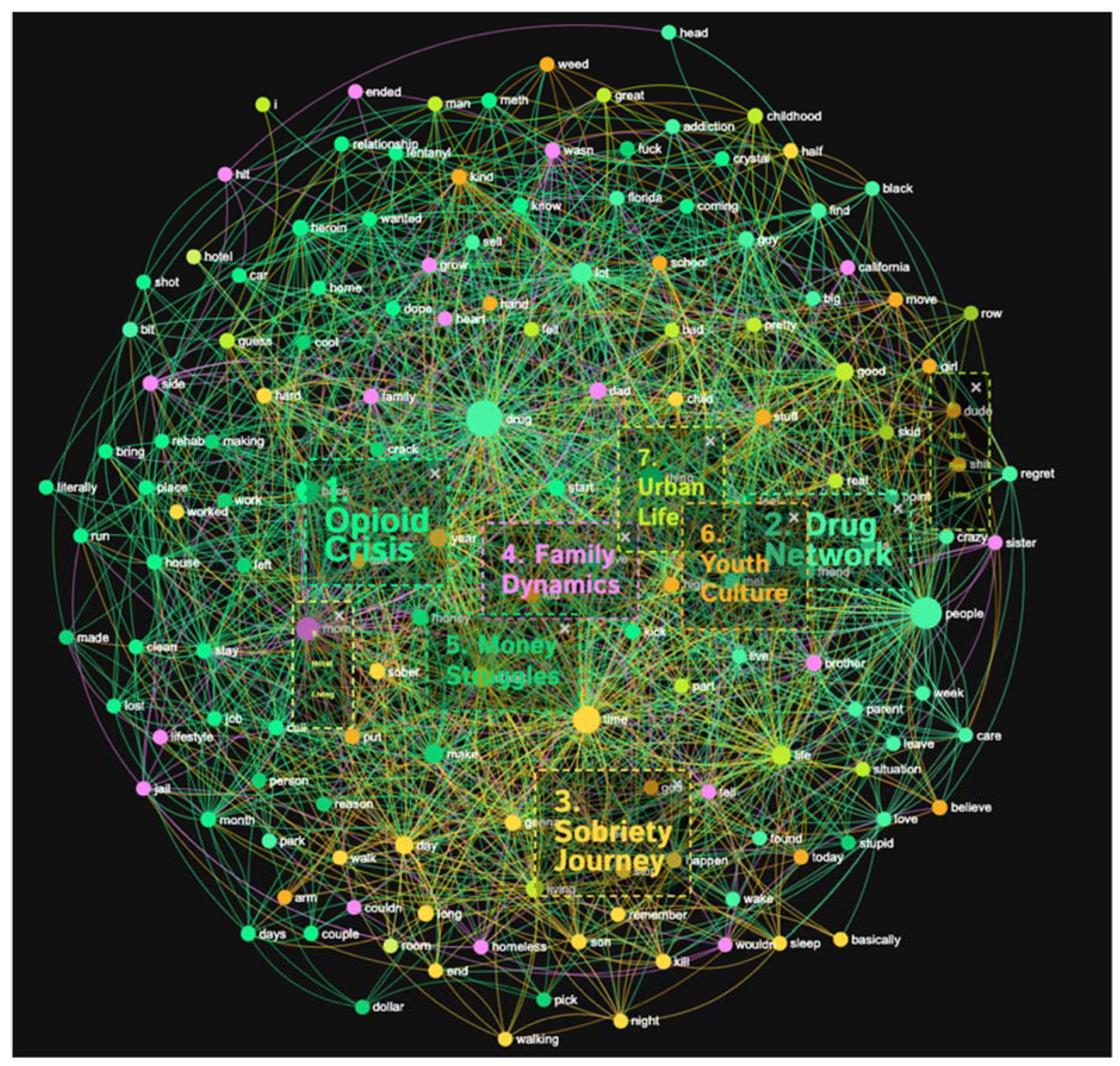
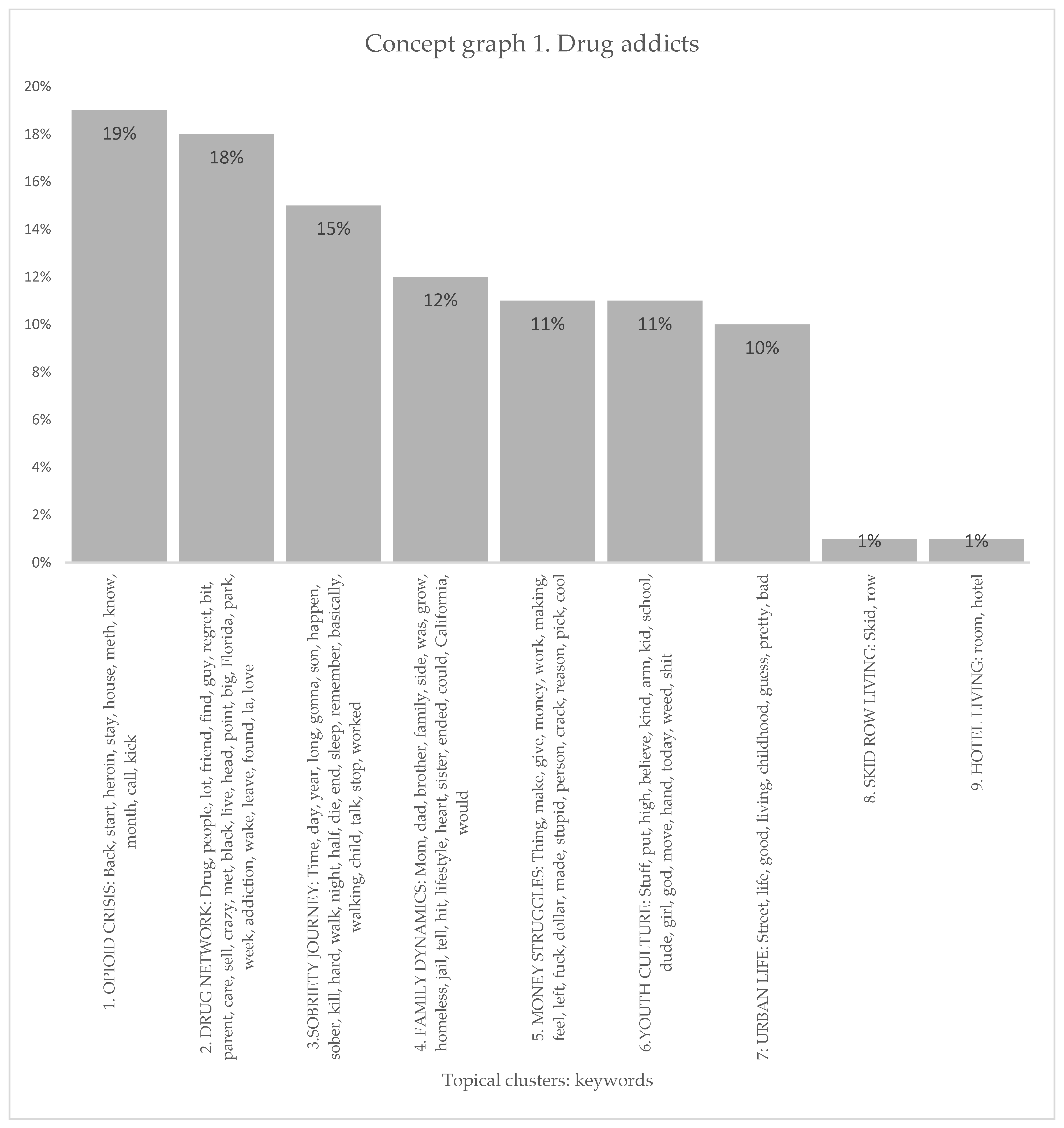
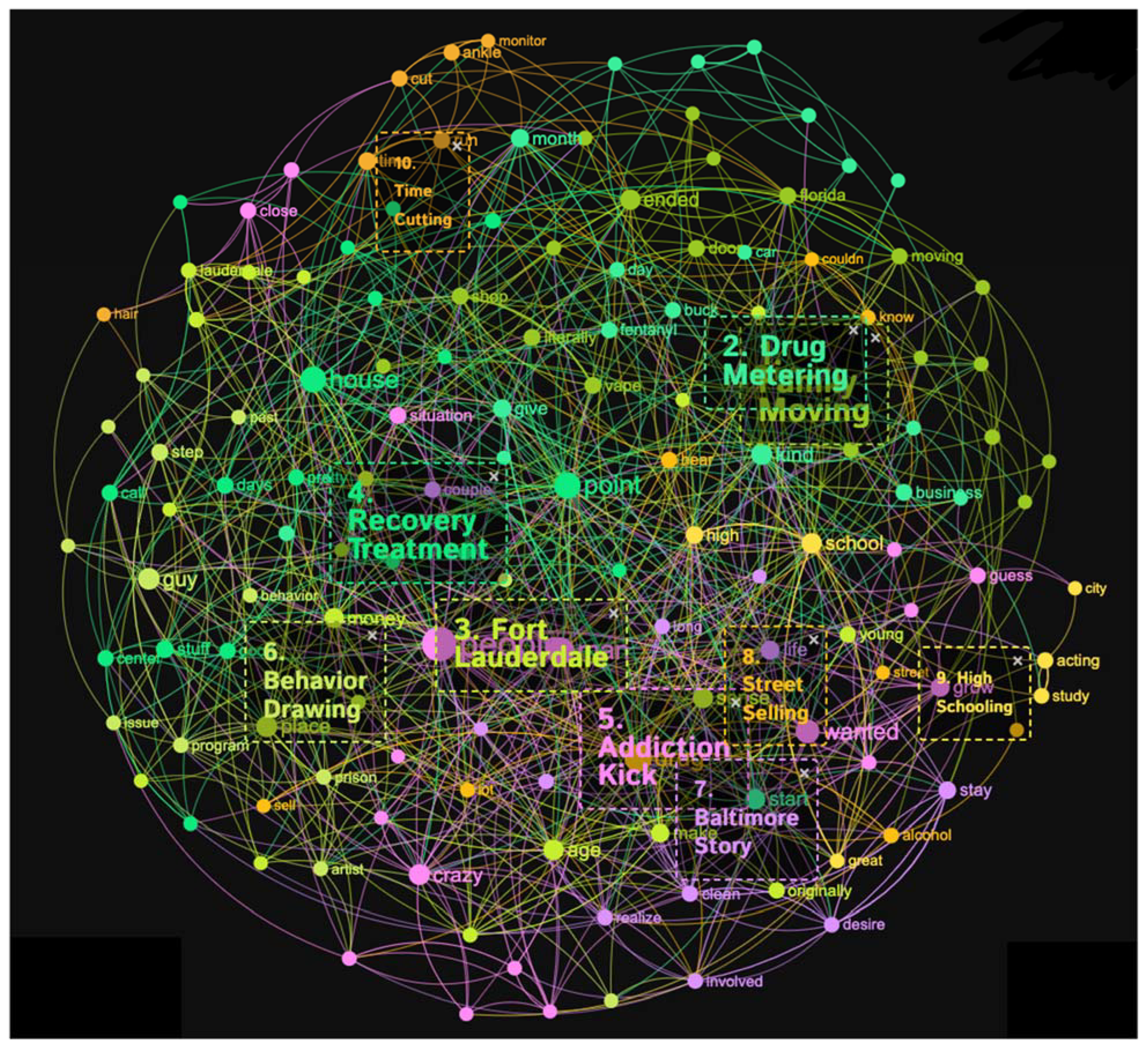
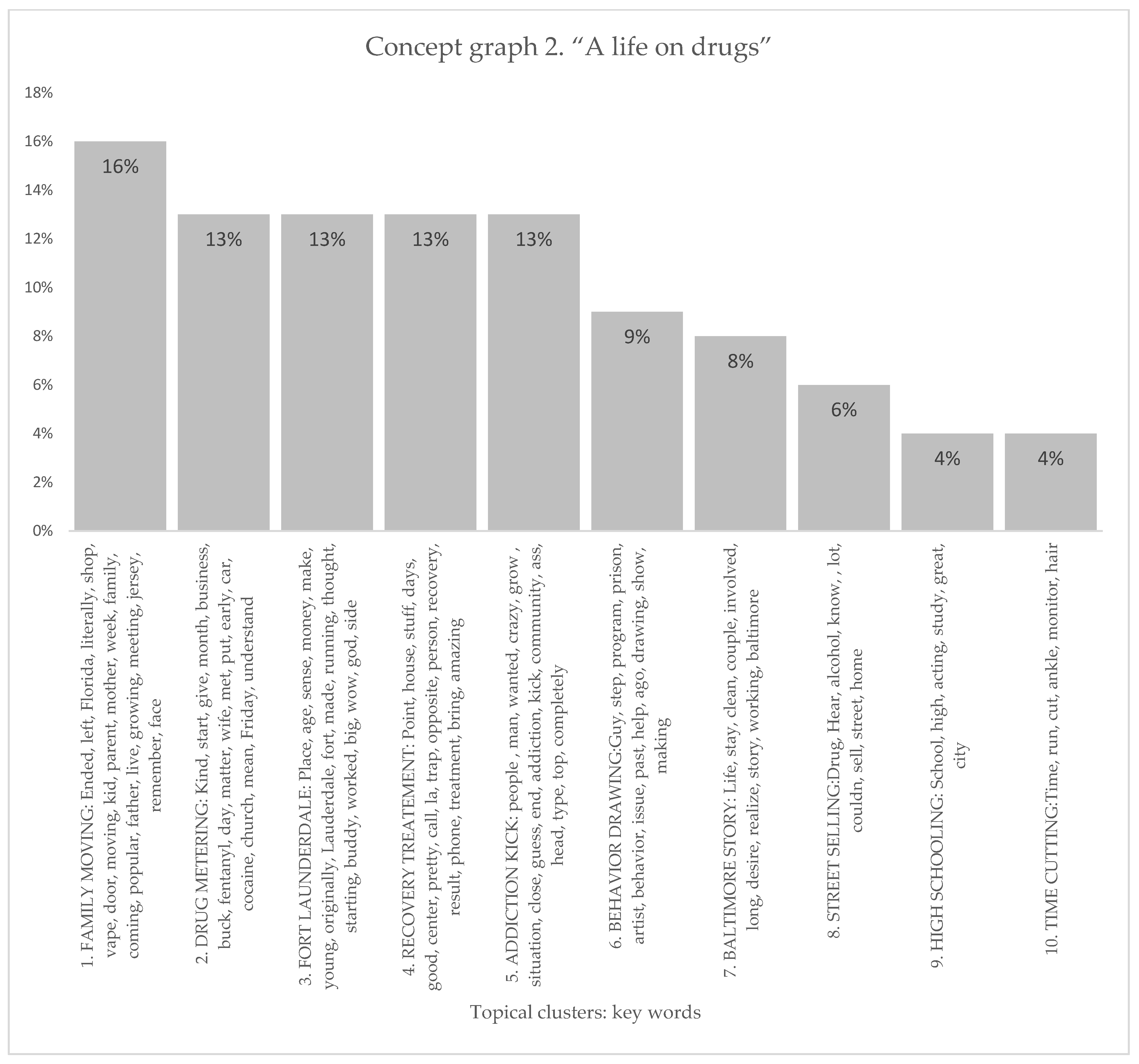
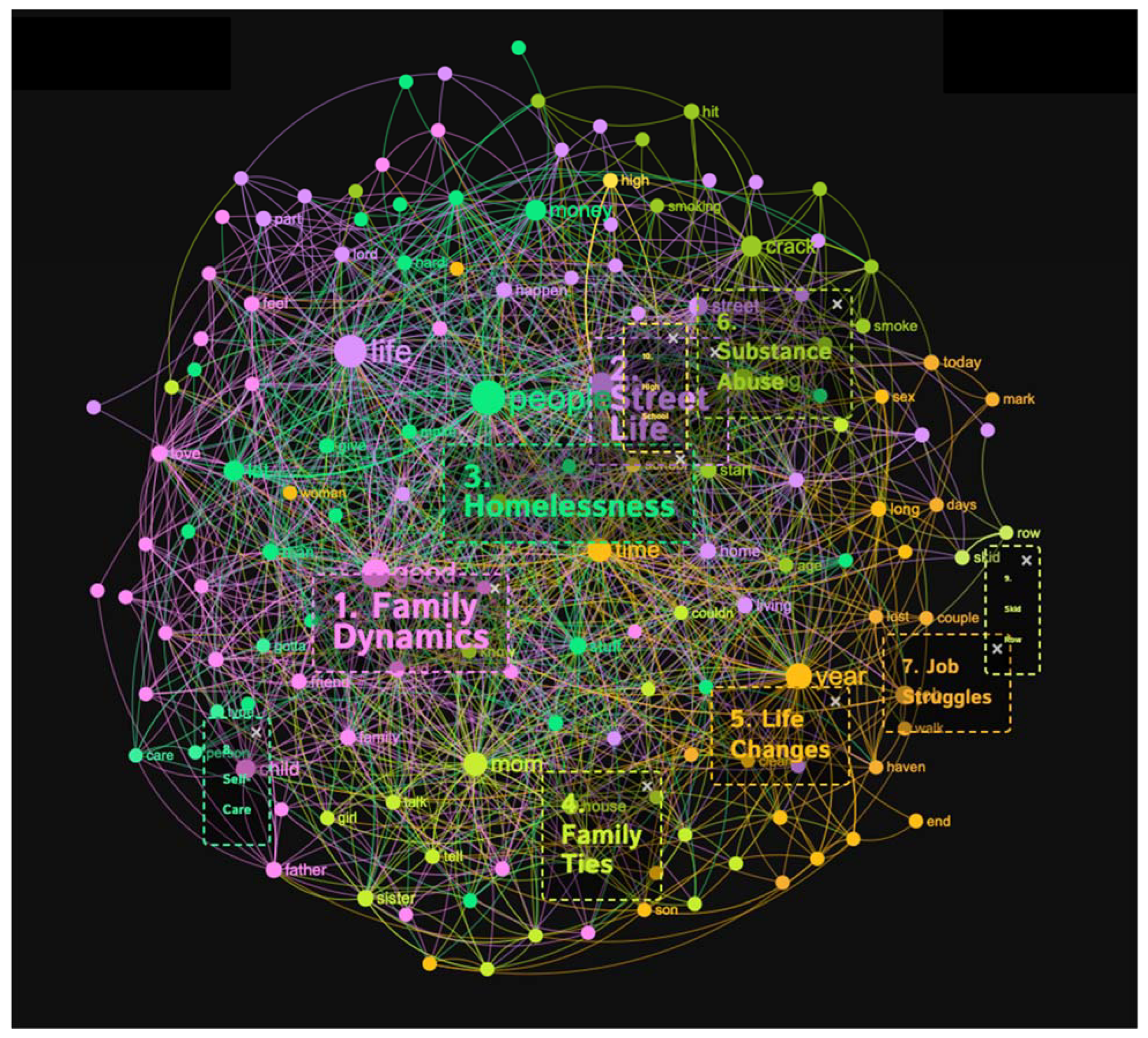
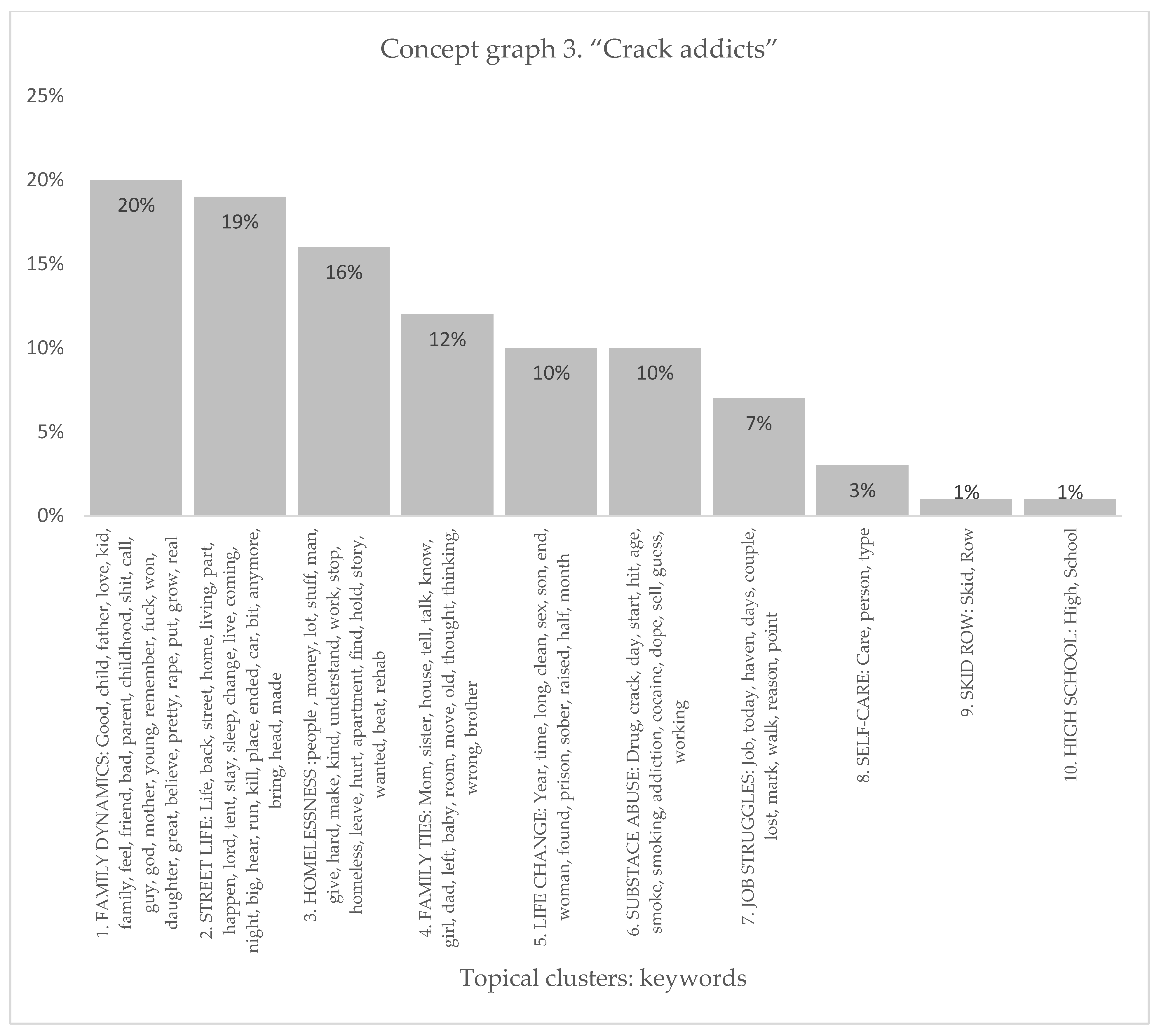
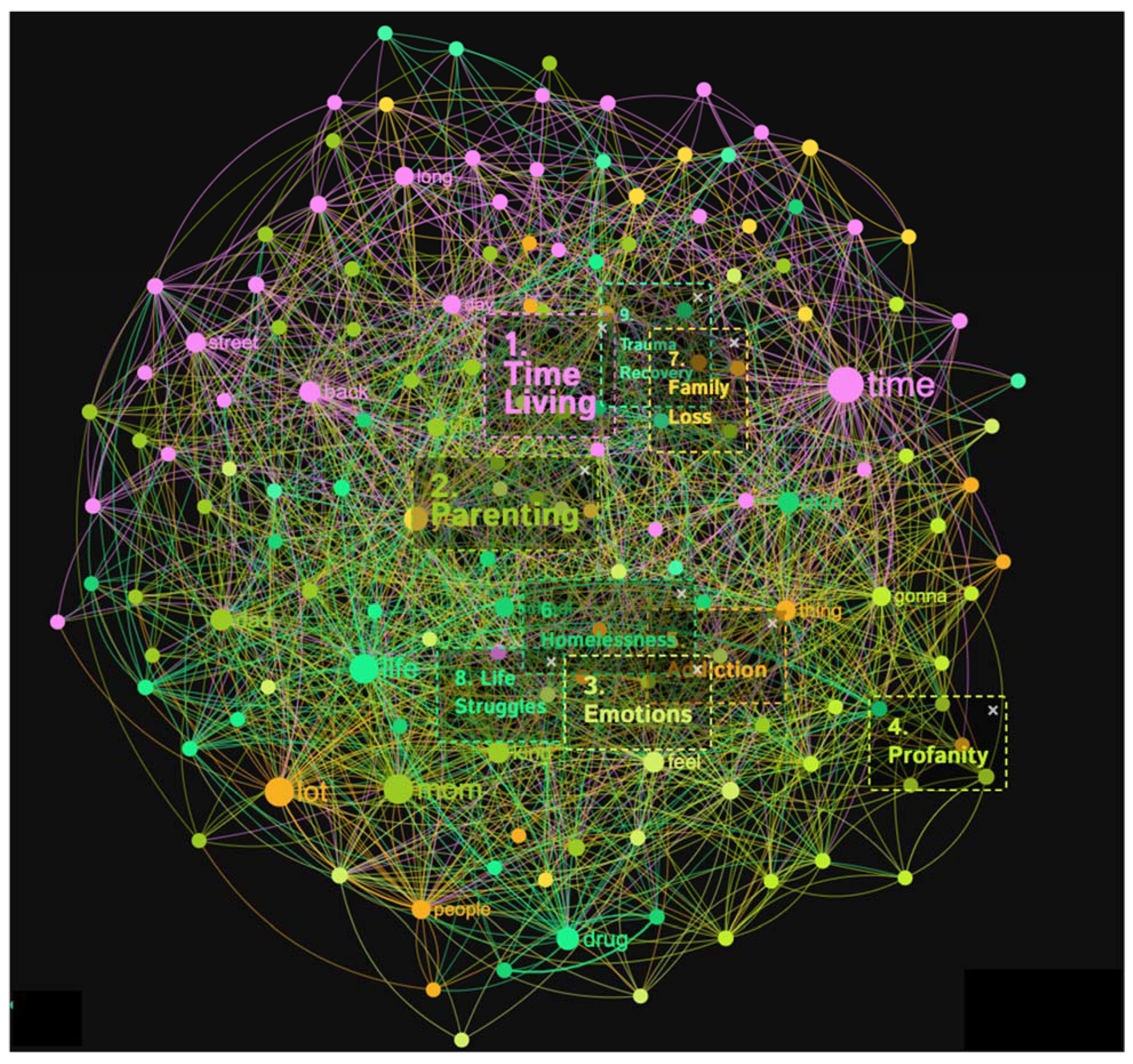
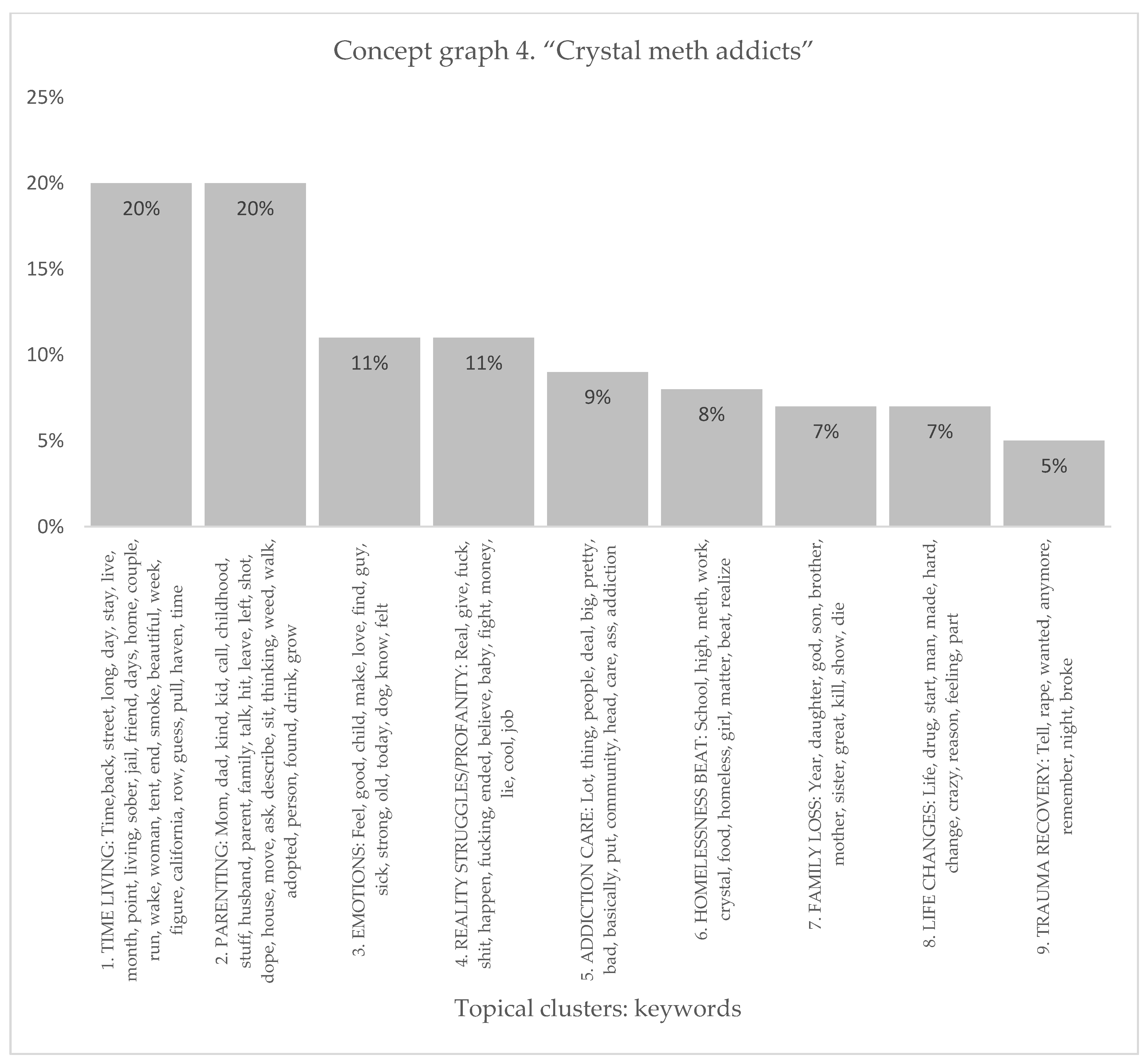
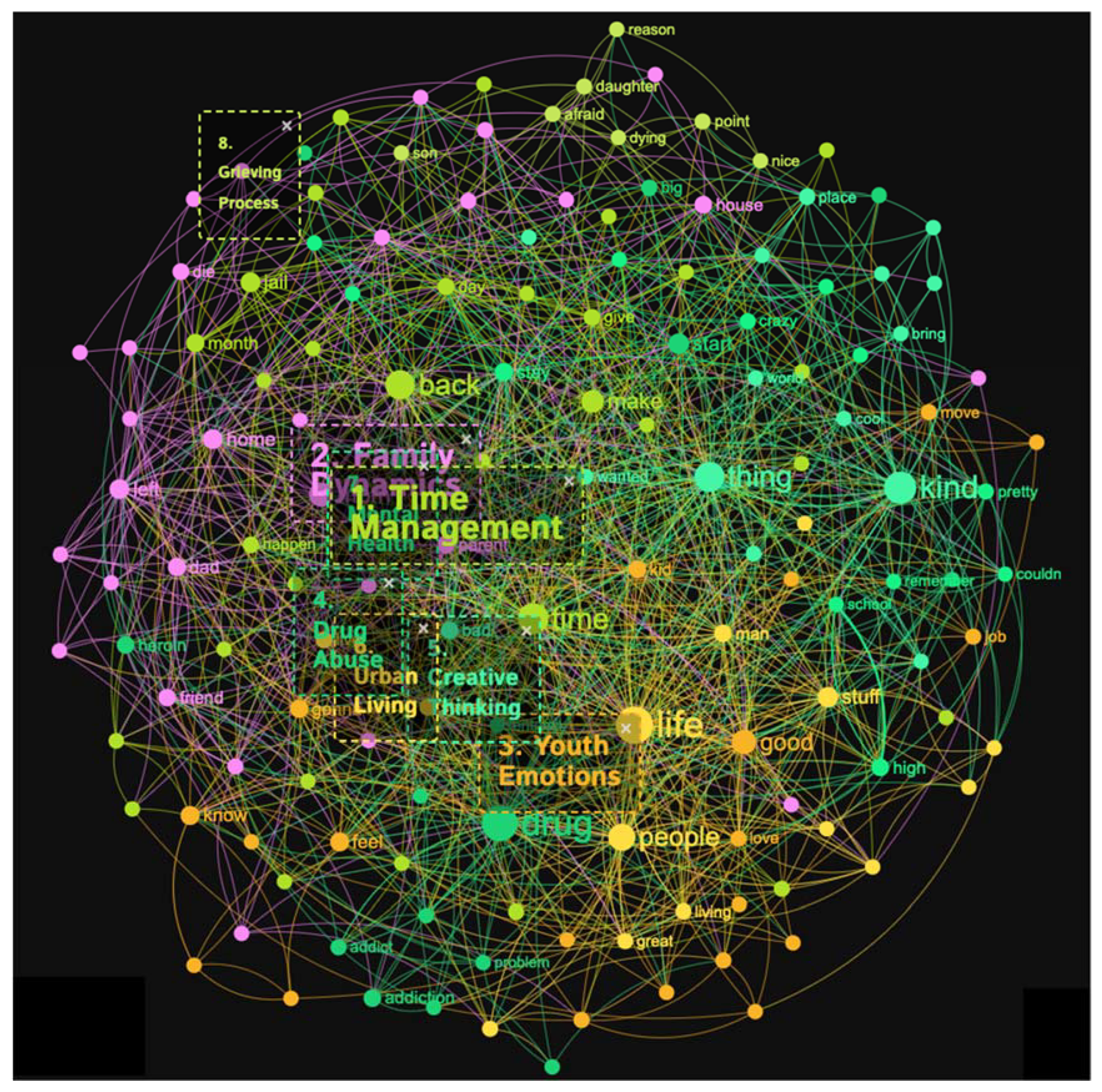
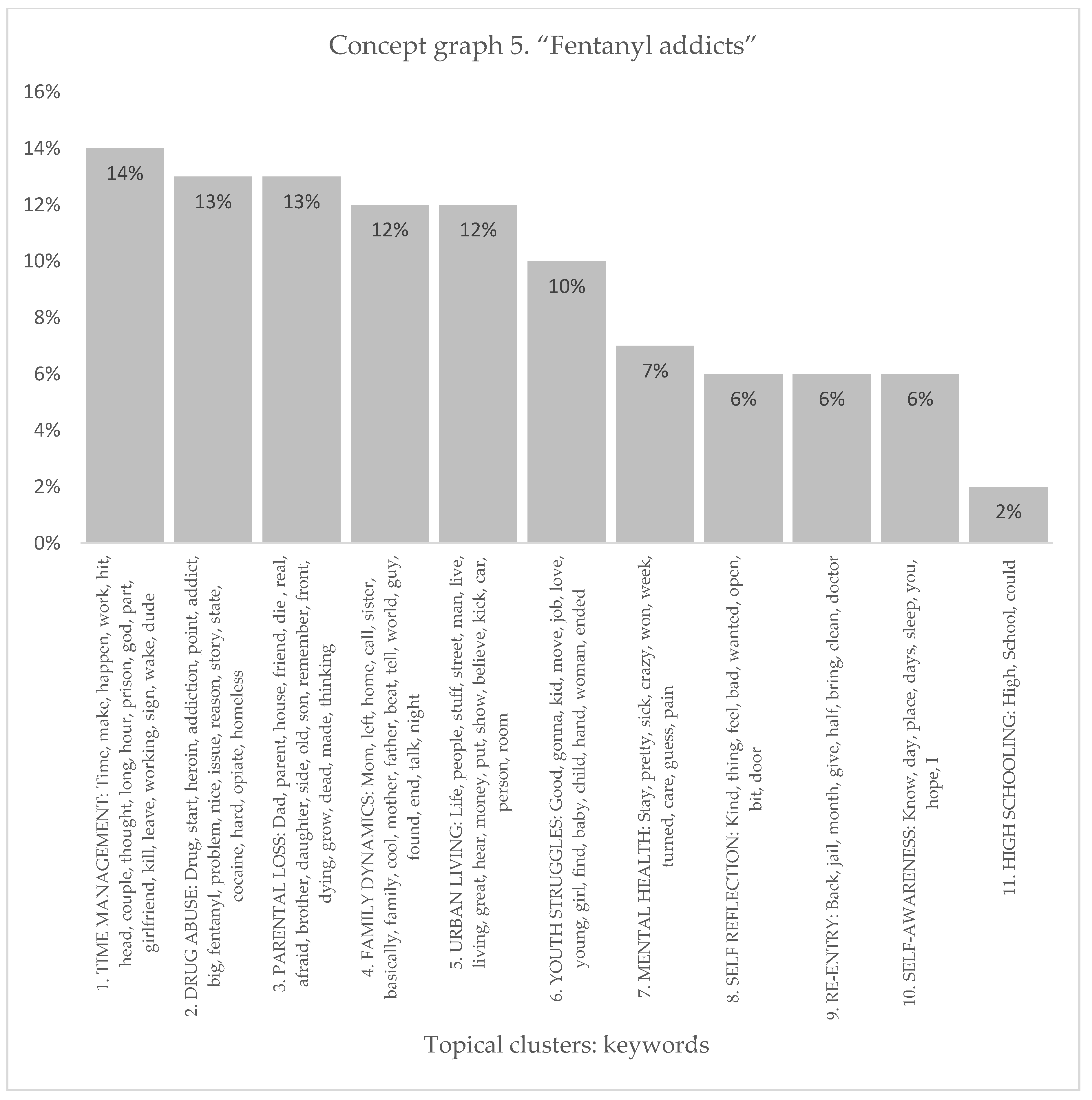
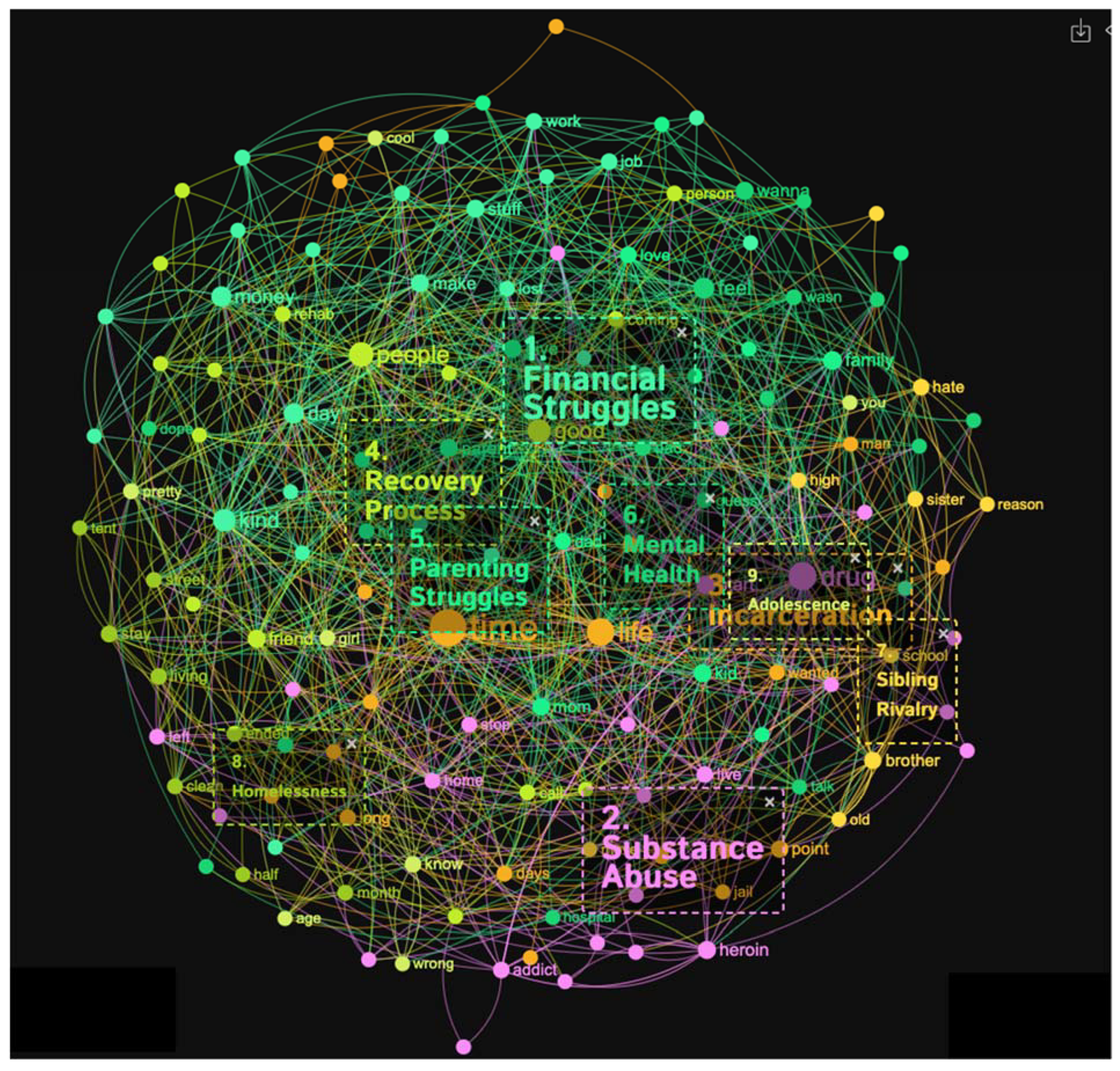
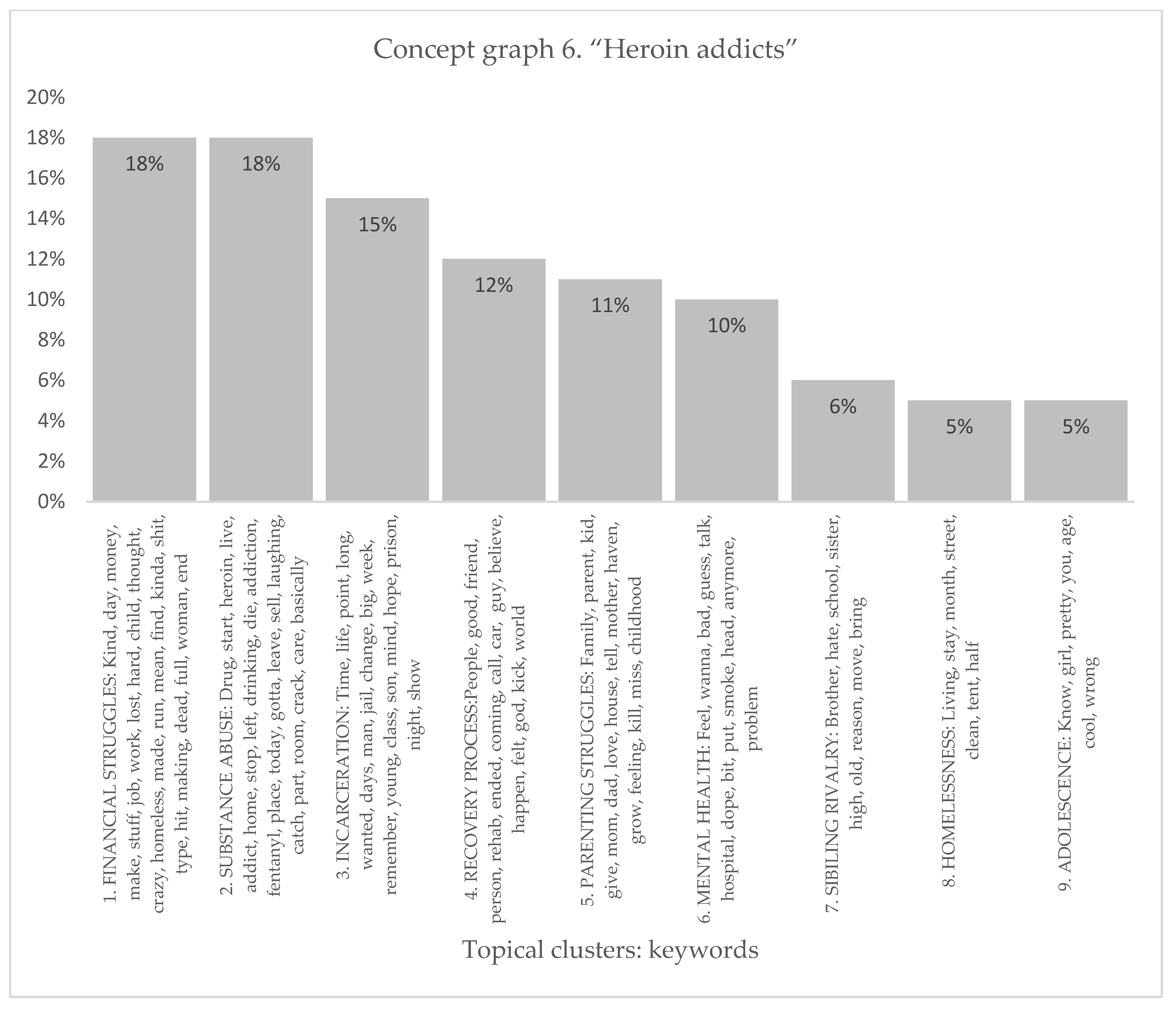
| Video Content Relevancy Assessment | Inclusion Criteria | Exclusion Criteria |
|---|---|---|
|
|
|
| Case Identifier | No. of Individuals Interviewed | No. of Videos | No. of Words in Transcript |
|---|---|---|---|
| Drug addicts (Drug type unspecified) | 19 | 20 | 74,570 |
| “A life on drugs” | 6 | 6 | 35,860 |
| Crack addicts | 50 | 55 | 212,133 |
| Crystal meth addicts | 58 | 63 | 202,251 |
| Fentanyl addicts | 78 | 88 | 339,028 |
| Heroin addicts | 77 | 83 | 239,686 |
| Total | 288 | 315 | 1,103,528 |
| Conceptual Graphs | Similar Themes within Other Conceptual Graphs | Organized Phrases According to Themes | Evolution of Themes |
|---|---|---|---|
| Drug addicts | 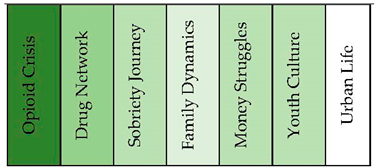 |
|  |
| Life on Drug |  | ||
| Crack addicts | 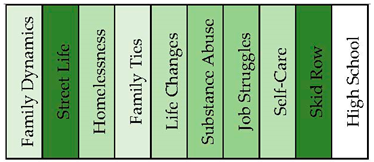 | ||
| Crystal meth addicts | 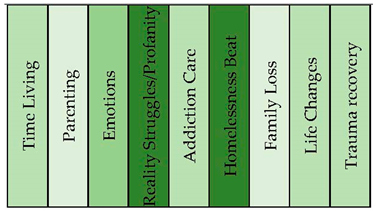 | ||
| Fentanyl addicts | 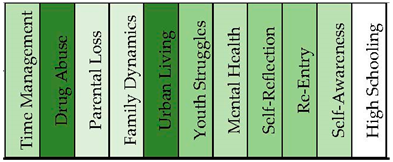 | ||
| Heroin addicts | 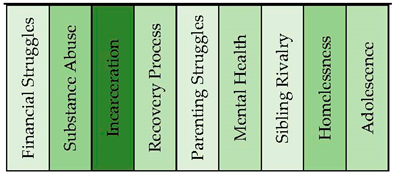 |
Disclaimer/Publisher’s Note: The statements, opinions and data contained in all publications are solely those of the individual author(s) and contributor(s) and not of MDPI and/or the editor(s). MDPI and/or the editor(s) disclaim responsibility for any injury to people or property resulting from any ideas, methods, instructions or products referred to in the content. |
© 2023 by the authors. Licensee MDPI, Basel, Switzerland. This article is an open access article distributed under the terms and conditions of the Creative Commons Attribution (CC BY) license (https://creativecommons.org/licenses/by/4.0/).
Share and Cite
Feyissa, I.F.; Zhang, N. When Unstructured Big Text Corpus Meets Text Network Analysis: Social Reality Conceptualization and Visualization Graph of Big Interview Data of Heavy Drug Addicts of Skid Row. Healthcare 2023, 11, 2439. https://doi.org/10.3390/healthcare11172439
Feyissa IF, Zhang N. When Unstructured Big Text Corpus Meets Text Network Analysis: Social Reality Conceptualization and Visualization Graph of Big Interview Data of Heavy Drug Addicts of Skid Row. Healthcare. 2023; 11(17):2439. https://doi.org/10.3390/healthcare11172439
Chicago/Turabian StyleFeyissa, Israel Fisseha, and Nan Zhang. 2023. "When Unstructured Big Text Corpus Meets Text Network Analysis: Social Reality Conceptualization and Visualization Graph of Big Interview Data of Heavy Drug Addicts of Skid Row" Healthcare 11, no. 17: 2439. https://doi.org/10.3390/healthcare11172439
APA StyleFeyissa, I. F., & Zhang, N. (2023). When Unstructured Big Text Corpus Meets Text Network Analysis: Social Reality Conceptualization and Visualization Graph of Big Interview Data of Heavy Drug Addicts of Skid Row. Healthcare, 11(17), 2439. https://doi.org/10.3390/healthcare11172439








